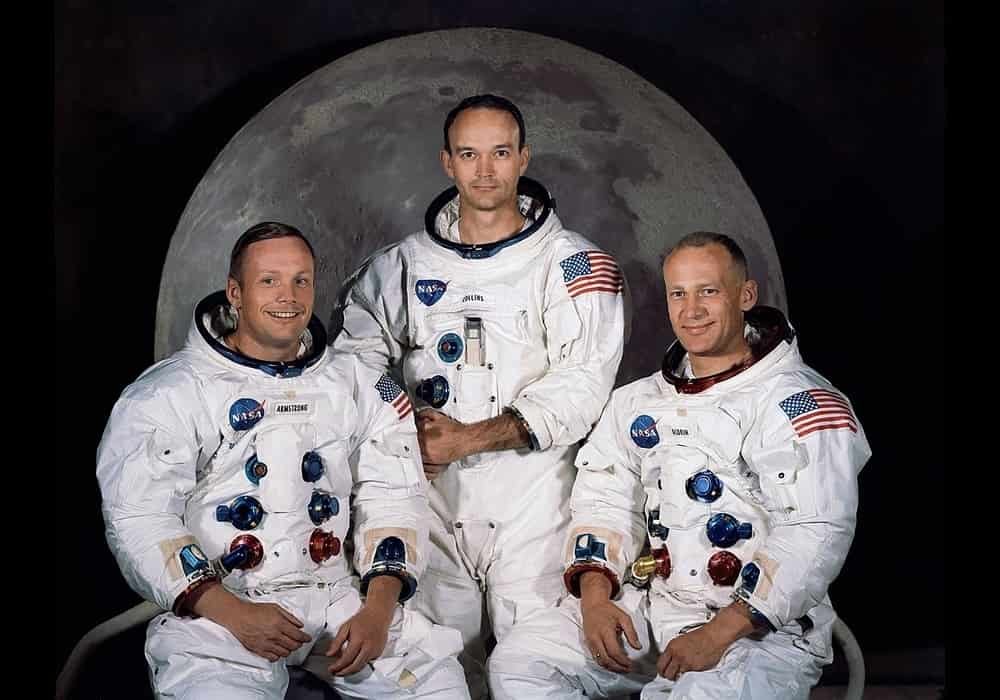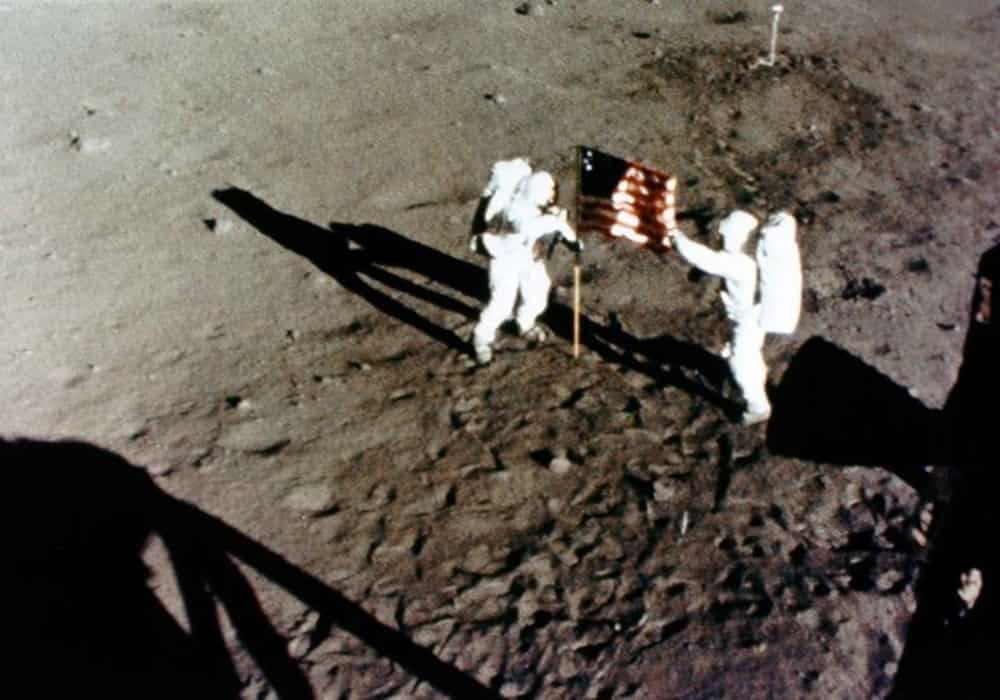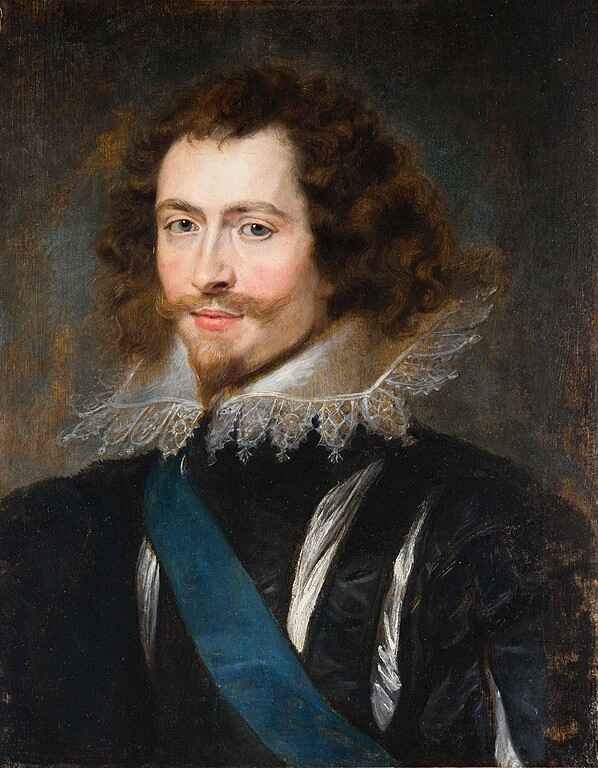Apollo 11
Apollo 11 is a mission of the American Apollo space program during which, for the first time, men landed on the Moon, Monday, July 21, 1969. It was the fifth manned flight of the Apollo program of the US space agency NASA, thus fulfills the objective set by President John F. Kennedy in 1961 to land a crew on the Moon before the end of the 1960s. It was a question of demonstrating the superiority of the United States over the Soviet Union which had been undermined by the successes Soviets at the start of the space age in the context of the Cold War which then opposed these two countries. This challenge is launched when NASA has not yet placed a single astronaut in orbit. Thanks to the mobilization of considerable human and financial resources, the space agency caught up and then exceeded the Soviet space program.
Culmination of a series of missions
Apollo 11 is the culmination of a series of missions that allow the development of the necessary space techniques, spacecraft and a giant launcher as well as the reconnaissance of landing sites on the Moon. This is the third crewed mission to enter a lunar orbit after Apollo 8 and Apollo 10. The spacecraft carrying the crew was launched from the Kennedy Space Center on July 16, 1969 by the giant Saturn V rocket developed for this program. . It carries a crew composed of Neil Armstrong, mission commander and lunar module pilot, Edwin “Buzz” Aldrin, who accompanies Armstrong on lunar soil, and Michael Collins, command and service module pilot who will remain in operation. lunar orbit. Armstrong and Aldrin, after a landing with a few twists and turns, spent 21 hours and 36 minutes on the surface of the Moon and carried out a unique spacewalk lasting 2 hours and 31 minutes. After taking off again and making a rendezvous in lunar orbit with the command and service module, the Apollo spacecraft resumed its journey to Earth and landed without incident in the Pacific Ocean at the end of a mission that lasted 8 days, 3 hours and 18 minutes.
During this mission, 21.7 kilograms of rock and lunar soil are collected and several scientific instruments are installed on the surface of our satellite. Although the scientific objective of Apollo 11 was limited by the length of stay on the Moon and the reduced carrying capacity of the spacecraft used, the mission provides substantial results. Its unfolding, in particular the first steps on the Moon filmed by a video camera and broadcast live, constitute an event followed all over the planet by hundreds of millions of people.
Apollo 11: an extraordinary journey!
In 1969, a space mission to our satellite called Apollo 11 resulted in man’s first steps on the moon. Reality goes beyond fiction, and the commonalities between the book and the Apollo 11 mission are ultimately startling. We take a look back at the key moments of the trip that took Niel Armstrong and Buzz Aldrin to the Moon, not to mention Michael Collins who remained in orbit in the Command and Service Module (CSM).
July 16
Take off from Florida for the Apollo 11 mission At 13:32 (UTC) take off of the Saturn V launcher from Cape Canaveral in Florida. This launch site is located about 225 km from the Stone Hill site, imagined by Jules Verne, near the city of Tampa which actually exists. After a few stops and ignition of the engines, we can note an important maneuver after a little more than 3 hours of flight: the reversal and the mooring of the Lunar Module (LM) with the CSM. The Command Module is also called Columbia. Small reference to the writer since in the novel the cannon that propels the spaceship is called Columbiad. The Apollo 11 team is well on its way to the moon.
3 days later, July 19
The spacecraft approaches the moon On July 19 at 5:22 pm the team found itself in orbit around the moon. The Apollo 11 spacecraft therefore makes a 3-day Earth-Moon journey. Again, similarity to the title of the work which reads From the Earth to the Moon, direct journey in 97 hours 20 minutes.
July 20
An Eventful Landing Phase After 9 revolutions around the Moon, Armstrong and Aldrin join the Eagle Lunar Module, leaving Collins behind in Columbia. During the flight over the hidden face (13th revolution), the LM separated from the CSM at 5.44 p.m. Ignition of the engine allows the LM to descend to the lunar surface. By returning to the visible side, communications resume and we realize that the current trajectory causes a shift in the landing site. The saturation of the on-board computer triggered 4 successive alarms, Armstrong switched to manual piloting in order to avoid a too hilly area. With the little fuel remaining (30 seconds of flight possible while the Eagle was 6 m above the ground), the LM finally landed at 8:17 p.m. The initially planned rest time will in fact allow the preparation of the scuba excursion.
July 21: the night of the feat!
Depressurization, the door opens and Armstrong treads the lunar floor at 2:56 am, then we hear “This is a small step for man, a giant leap for mankind.” For a little over 2 hours, shots are taken, the laser reflector and a seismometer are placed, and around 20 kilograms of moon rock are collected. Take off is not easy since the control allowing the engine to start is broken. Aldrin solves the problem by inserting the tip of his pen into the button. After 4 hours of flight, the LM rejoined the CSM. Collins then finds Armstrong then Aldrin 25 minutes later. The entire crew begins the return to Earth.
July 24
A shattering return to Earth for Apollo 11 At 5,500 km from Earth, the Service Module is separated from the Command Module where the men are located. Entry into the atmosphere is at very high speed, for 9 minutes communication with the ground is impossible. The opening of the parachutes makes it possible to reduce the speed from 480 to 280 km / h and finally the landing in the Pacific Ocean takes place at 4:50 p.m.
The recovery is carried out with the aircraft carrier USS Hornet. In his novel, Jules Verne also imagined the intervention of the Navy via the USS Susquehanna. Moreover, the real and imaginary fall site are only 5,450 km apart. This achievement in 1969 marked a turning point in the history of aerospace, with a total of 12 men who walked on the moon.

Death of American astronaut Michael Collins, third man in the historic Apollo-11 mission
In July 1969, Neil Armstrong and Buzz Aldrin walked on the moon. He, who remained in orbit in the control module, had to content himself with contemplating our satellite from above.
American astronaut Michael Collins, who died of cancer on April 28, 2021 at the age of 90, had heard the most about himself. Third man in the historic Apollo-11 mission in which, in July 1969, his comrades Neil Armstrong and Buzz Aldrin walked on the moon. They were the first two in history. He, who remained in orbit in the command module, had to content himself with looking down on our satellite, on which he was never to set foot.
Born October 31, 1930 in Rome, where his father, General James Collins, was a military attaché at the US Embassy, Michael Collins followed the classic route of most NASA astronauts at the time. First a pilot in the army, he became a test pilot in 1960. He applied for the first time, unsuccessfully, to join the astronaut corps and was accepted on his second attempt in 1963.
The only member of the Apollo 11 crew who did not walk on the Earth satellite (Moon), he says he has retained no bitterness. Like Aldrin and Armstrong, Collins quickly left NASA after the triumphant return to Earth and pursued a rich public career.
He had been appointed Deputy Secretary of State for Public Affairs by President Richard Nixon, then directed the construction of the Washington Air Museum, assuming the presidency (1971-1978). He then became a consultant and wrote books related to space adventure.

Mission objectives
Apollo 11 is the first Apollo mission to land men on lunar soil and although part of its unfolding was rehearsed during the Apollo 10 flight, crucial phases like the landing and take-off of the Moon as well as the use of the spacesuit on the lunar soil have never been realized and present significant risks. In this context, scientific research plays a secondary role in the mission: the Apollo 11 crew’s main objective is to carry out a spacewalk on lunar soil and to return safely to Earth. He will thus have achieved the goal set by President John F. Kennedy in his speech of May 25, 1961: to drop a man on the Moon and return to Earth, before the end of the decade.
Among the secondary technical objectives are:
- the collection of the elements allowing to validate the technical solutions adopted for the landing (examination of the landing gear), the stay on the Moon and the spacewalks;
- soil mechanical resistance tests;
- visibility assessment;
- assessing the capabilities and limitations of a human crew moving on lunar soil;
- determining the coordinates of the landing site.
Sources: PinterPandai, NASA,



